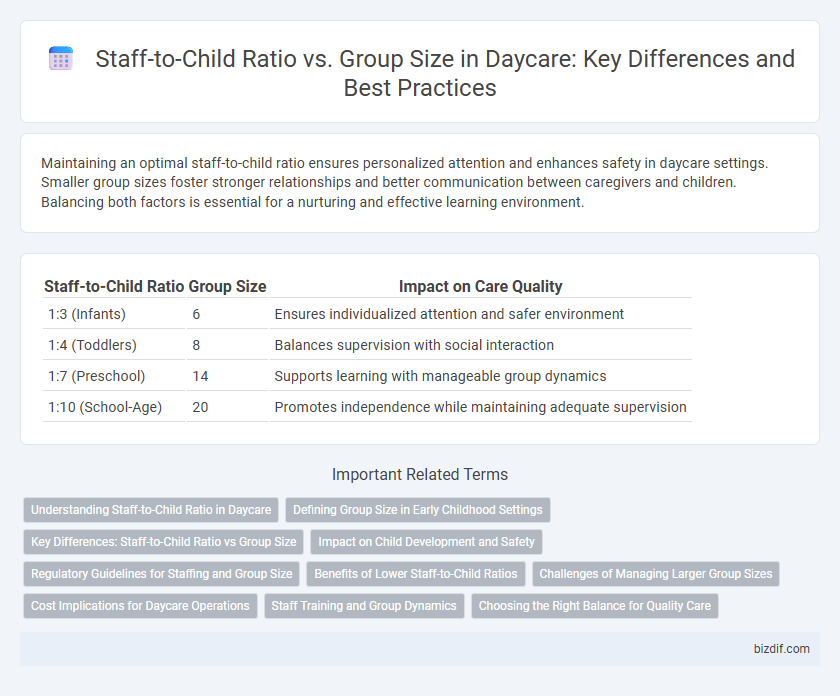Maintaining an optimal staff-to-child ratio ensures personalized attention and enhances safety in daycare settings. Smaller group sizes foster stronger relationships and better communication between caregivers and children. Balancing both factors is essential for a nurturing and effective learning environment.
Table of Comparison
| Staff-to-Child Ratio | Group Size | Impact on Care Quality |
|---|---|---|
| 1:3 (Infants) | 6 | Ensures individualized attention and safer environment |
| 1:4 (Toddlers) | 8 | Balances supervision with social interaction |
| 1:7 (Preschool) | 14 | Supports learning with manageable group dynamics |
| 1:10 (School-Age) | 20 | Promotes independence while maintaining adequate supervision |
Understanding Staff-to-Child Ratio in Daycare
Staff-to-child ratio in daycare refers to the number of caregivers assigned to a specific number of children, ensuring safety and personalized attention. Maintaining an optimal ratio, such as 1:4 for infants and 1:8 for preschoolers, directly impacts the quality of care and regulatory compliance. Understanding this ratio helps parents assess the level of supervision, engagement, and developmental support provided in a daycare setting.
Defining Group Size in Early Childhood Settings
Group size in early childhood settings refers to the total number of children cared for within a single classroom or designated area, directly impacting the social environment and quality of interactions. Maintaining optimal group sizes ensures that children receive adequate attention, promoting safety and individualized learning experiences. Group size standards vary but commonly align with regulatory guidelines that balance staffing resources and developmental needs.
Key Differences: Staff-to-Child Ratio vs Group Size
Staff-to-child ratio refers to the specific number of caregivers assigned per child, ensuring personalized attention and safety, while group size indicates the total number of children within a single classroom or setting. Maintaining low staff-to-child ratios allows for better supervision and individualized care, whereas smaller group sizes contribute to a calmer, more manageable environment and facilitate social interactions among children. Both factors are critical in daycare quality standards, impacting developmental outcomes and regulatory compliance.
Impact on Child Development and Safety
Maintaining an optimal staff-to-child ratio enhances individualized attention, fostering cognitive and emotional development in young children. Smaller group sizes reduce overstimulation and enable caregivers to closely monitor each child, significantly improving safety and well-being. Research from the National Association for the Education of Young Children (NAEYC) highlights that low ratios and limited group sizes correlate with stronger developmental outcomes and decreased incidents of injury.
Regulatory Guidelines for Staffing and Group Size
Regulatory guidelines for daycare staffing emphasize maintaining optimal staff-to-child ratios to ensure safety and personalized care, typically ranging from 1:3 for infants to 1:10 for older preschoolers. Group size limits complement these ratios by capping the total number of children in a room, often varying between 8 to 20 depending on age and jurisdiction. Adherence to both staffing ratios and group size limits is critical for compliance with licensing standards and promoting a nurturing learning environment.
Benefits of Lower Staff-to-Child Ratios
Lower staff-to-child ratios in daycare settings enhance personalized attention, fostering stronger developmental support and improved safety for each child. Smaller groups enable caregivers to better monitor individual needs, resulting in higher quality interactions and more effective early learning experiences. Research consistently shows that reduced ratios contribute to better social, cognitive, and emotional outcomes for children in early childhood education.
Challenges of Managing Larger Group Sizes
Managing larger group sizes in daycare settings presents significant challenges in maintaining an optimal staff-to-child ratio, which is crucial for ensuring personalized attention and safety. Increased group sizes often lead to reduced individual supervision, heightening the risk of accidents and behavioral issues among children. Effective management requires strategic staffing and organizational measures to uphold developmental and regulatory standards despite the complexity of overseeing more children simultaneously.
Cost Implications for Daycare Operations
Maintaining a low staff-to-child ratio directly increases labor costs, impacting the overall budget and pricing structure of daycare operations. Larger group sizes can reduce per-child expenses but may compromise individualized attention and care quality, affecting regulatory compliance and parent satisfaction. Balancing staff-to-child ratios with group sizes is essential for cost-effective daycare management while ensuring safety and developmental benefits.
Staff Training and Group Dynamics
Optimal staff-to-child ratios combined with well-trained staff enhance group dynamics by ensuring personalized attention and fostering positive interactions among children. Comprehensive staff training equips caregivers with strategies to manage diverse group behaviors effectively, reducing conflicts and promoting a nurturing environment. Maintaining small group sizes further supports individualized care, allowing staff to implement developmentally appropriate activities tailored to each child's needs.
Choosing the Right Balance for Quality Care
Maintaining an optimal staff-to-child ratio is essential for individualized attention and safety in daycare settings, while group size influences social interaction and overall environment quality. Smaller ratios allow caregivers to respond promptly to children's needs, fostering development and reducing stress, whereas manageable group sizes promote positive peer relationships without overwhelming staff. Balancing these factors ensures a nurturing atmosphere that supports both personalized care and dynamic group engagement.
Staff-to-Child Ratio vs Group Size Infographic

 bizdif.com
bizdif.com